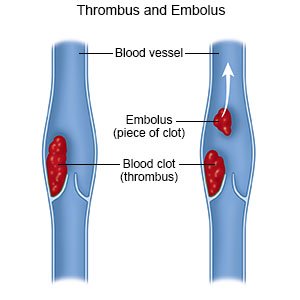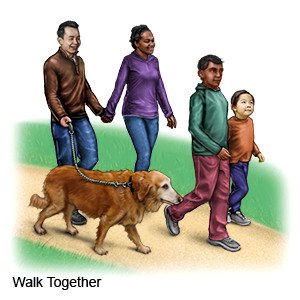Cardiac Thrombolysis
Medically reviewed by Drugs.com. Last updated on Jun 5, 2024.
AMBULATORY CARE:
What you need to know about cardiac thrombolysis:
Cardiac thrombolysis is a procedure to dissolve or break up a blood clot near your heart. The clot may be removed with a device during the procedure. A clot that forms in the arteries or chambers of the heart can cause a heart attack. The clot can cause a stroke if it breaks off and travels to your brain. Thrombolysis needs to be done as quickly as possible to prevent heart damage or a stroke.
 |
How to prepare for the procedure:
Cardiac thrombolysis is often an emergency procedure. This means you may not have time to prepare for it. The following is general information if you have time to prepare:
- Your healthcare provider will tell you how to prepare for your procedure. He or she may tell you not to eat or drink anything after midnight on the day of your procedure. Arrange to have someone drive you home when you leave the hospital.
- Tell your provider about all your current medicines. He or she will tell you if you need to stop any medicine for the procedure, and when to stop. He or she will tell you which medicines to take or not take on the day of your procedure.
- Tell your provider about any allergies you have, including to anesthesia, contrast liquid, or medicines. You may be given an antibiotic to help prevent an infection caused by bacteria. You may be given contrast liquid before or during the procedure to help the clot show up in pictures.
- You may need blood tests and a stress test before your procedure. Talk to your provider about these or other tests you may need.
What will happen during the procedure:
- You may be given local anesthesia to numb the procedure site. With local anesthesia, you may still feel pressure or pushing, but you should not feel any pain. You may instead be given general anesthesia to keep you asleep and free from pain.
- Your healthcare provider will inject medicine into your IV that will help dissolve or break up the clot. It is most often given into a vein, but it may be given into an artery. If the medicine is given into an artery, a catheter is guided by x-ray so it is near the blood clot.
What to expect after the procedure:
Healthcare providers will apply pressure on the procedure site to stop any bleeding. You will be monitored closely for any problems. Do not get out of bed until your healthcare provider says it is okay. You will then be taken to your hospital room.
- You will be helped to walk around after the procedure. Movement will help prevent blood clots. You may also be given exercises to do in bed. Do not get out of bed on your own until your healthcare provider says you can. Ask before you get up the first time. You may need help to stand up safely. When you are able to get up on your own, sit or lie down right away if you feel weak or dizzy. Then press the call button to let someone know you need help.
- Medicines:
- Anticoagulants are a type of blood thinner medicine that helps prevent clots. Anticoagulants may cause you to bleed or bruise more easily.
- Antiplatelets help prevent blood clots. This medicine makes it more likely for you to bleed or bruise.
Risks of cardiac thrombolysis:
Thrombolysis increases your risk for bleeding. You may have increased nosebleeds or bleeding from your gums. You may also have bleeding in your stomach or brain. Bleeding can become severe and life-threatening. If the clot is removed, the device used may cause an irregular heartbeat. You may also have an allergic reaction to the contrast liquid or to the medicine used to break up the clot.
Call your local emergency number (911 in the US) for any of the following:
- You have any of the following signs of a heart attack:
- Squeezing, pressure, or pain in your chest
- You may also have any of the following:
- Discomfort or pain in your back, neck, jaw, stomach, or arm
- Shortness of breath
- Nausea or vomiting
- Lightheadedness or a sudden cold sweat
- You have any of the following signs of a stroke:
- Numbness or drooping on one side of your face
- Weakness in an arm or leg
- Confusion or difficulty speaking
- Dizziness, a severe headache, or vision loss
Seek care immediately if:
- Your heart is beating faster than usual.
- The procedure area does not stop bleeding even after you apply firm pressure for 10 minutes.
- The procedure area is numb, painful, or changes color.
- You see blood in your urine.
- The bruise at your catheter site gets bigger or becomes swollen.
- You have purple spots or blisters on your skin.
Call your doctor or cardiologist if:
- You have a fever.
- You have a new skin rash and itching.
- You feel weak, lightheaded, or faint.
- You have new swelling around your eyes.
- You have questions or concerns about your condition or care.
Medicines:
- Antiplatelets , such as aspirin, help prevent blood clots. Take your antiplatelet medicine exactly as directed. These medicines make it more likely for you to bleed or bruise. If you are told to take aspirin, do not take acetaminophen or ibuprofen instead.
- Blood thinners help prevent blood clots. Clots can cause strokes, heart attacks, and death. Many types of blood thinners are available. Your healthcare provider will give you specific instructions for the type you are given. The following are general safety guidelines to follow while you are taking a blood thinner:
- Watch for bleeding and bruising. Watch for bleeding from your gums or nose. Watch for blood in your urine and bowel movements. Use a soft washcloth on your skin, and a soft toothbrush to brush your teeth. This can keep your skin and gums from bleeding. If you shave, use an electric shaver. Do not play contact sports.
- Tell your dentist and other healthcare providers that you take a blood thinner. Wear a bracelet or necklace that says you take this medicine.
- Do not start or stop any other medicines or supplements unless your healthcare provider tells you to. Many medicines and supplements cannot be used with blood thinners.
- Take your blood thinner exactly as prescribed by your healthcare provider. Do not skip does or take less than prescribed. Tell your provider right away if you forget to take your blood thinner, or if you take too much.
- Take your medicine as directed. Contact your healthcare provider if you think your medicine is not helping or if you have side effects. Tell your provider if you are allergic to any medicine. Keep a list of the medicines, vitamins, and herbs you take. Include the amounts, and when and why you take them. Bring the list or the pill bottles to follow-up visits. Carry your medicine list with you in case of an emergency.
Care for the procedure area as directed:
- Keep the procedure area clean and dry. Your healthcare provider will tell you when you can bathe. You will need to keep the bandage in place and dry for a day or two after your procedure. Cover the bandage with a plastic bag and tape the opening around your skin to keep water out.
- Wash the area with soap and water when it is okay to bathe without a bandage.
- Check the area each day for signs of infection. Examples include redness, swelling, and pus. Dry the area and put on new, clean bandages as directed. Change your bandage if it gets wet or dirty.
Watch for bleeding and bruising:
It is normal to have a bruise and soreness where the catheter went in. Contact your healthcare provider if your bruise gets larger. If the procedure area bleeds, use your hand to put pressure on the bandage. If you do not have a bandage, use a clean cloth to put pressure over and just above the area. Seek care immediately if the bleeding does not stop within 10 minutes.
Do not lift heavy objects after your procedure:
Your healthcare provider or cardiologist may tell you not to lift anything heavier than 10 pounds. For example, a gallon of milk weighs 8 pounds. Ask how much weight is safe for you to lift. You may need to be careful for a few weeks after your procedure.
Go to cardiac rehabilitation (rehab) as directed:
Cardiac rehab is a program run by specialists. You will learn to strengthen your heart safely and prevent more heart disease or another blood clot. The program includes exercise, relaxation, stress management, and heart-healthy nutrition. Healthcare providers will also check to make sure any medicines you are taking are working. The program may also include instructions for when you can drive, return to work, and do other normal daily activities.
Prevent another blood clot:
- Do not smoke. Nicotine and other chemicals in cigarettes and cigars can cause blood vessel and lung damage. Ask your healthcare provider for information if you currently smoke and need help to quit. E-cigarettes or smokeless tobacco still contain nicotine. Talk to your healthcare provider before you use these products.
- Drink liquids as directed. Liquids will help flush out the contrast material used during your procedure. Liquid can also help prevent blood clots. Ask your healthcare provider how much liquid to drink each day and which liquids are best for you.
- Stay active. An active lifestyle can help prevent blood clots. Try to get at least 30 minutes of activity on most days of the week. If you sit most of the day for work, stand or walk around every half hour. After an injury or illness, try to become active again as soon as possible. Activity can also help you manage your weight. Too much body weight can increases your risk for another blood clot.

- Manage other health conditions. Follow your healthcare provider's directions to manage health conditions that can cause a blood clot. Examples are high cholesterol and diabetes.
- Limit alcohol. Do not drink alcohol for 24 hours after your procedure. Then limit alcohol. Women should limit alcohol to 1 drink a day. Men should limit alcohol to 2 drinks a day. A drink of alcohol is 12 ounces of beer, 5 ounces of wine, or 1½ ounces of liquor.
Follow up with your doctor or cardiologist as directed:
Write down your questions so you remember to ask them during your visits.
© Copyright Merative 2024 Information is for End User's use only and may not be sold, redistributed or otherwise used for commercial purposes.
The above information is an educational aid only. It is not intended as medical advice for individual conditions or treatments. Talk to your doctor, nurse or pharmacist before following any medical regimen to see if it is safe and effective for you.
Learn more about Cardiac Thrombolysis
Care guides
Further information
Always consult your healthcare provider to ensure the information displayed on this page applies to your personal circumstances.
